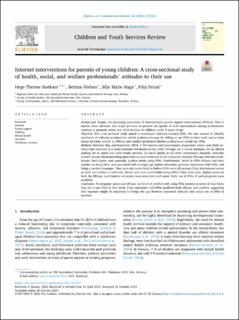| dc.contributor.author | Størksen, Hege Therese | |
| dc.contributor.author | Nielsen, Bettina | |
| dc.contributor.author | Haga, Silje Marie | |
| dc.contributor.author | Drozd, Filip | |
| dc.date.accessioned | 2024-03-07T11:13:44Z | |
| dc.date.available | 2024-03-07T11:13:44Z | |
| dc.date.created | 2023-10-27T09:58:48Z | |
| dc.date.issued | 2023 | |
| dc.identifier.citation | Størksen, H. T., Nielsen, B., Haga, S. M., & Drozd, F. (2023). Internet interventions for parents of young children: A cross-sectional study of health, social, and welfare professionals’ attitudes to their use. Children and Youth Services Review, 155, Artikkel 107253. | en_US |
| dc.identifier.issn | 0190-7409 | |
| dc.identifier.uri | https://hdl.handle.net/11250/3121413 | |
| dc.description.abstract | Background: Despite the increasing popularity of internet-based parent support interventions (IPSI[s]), little is known about attitudes that might promote or prevent the uptake of such interventions among professionals working in prenatal, infant and child services for children under 5 years of age.
Objective: This cross-sectional study aimed to investigate attitudes towards IPSIs. We also wanted to identify predictors of attitudes to determine which professionals may be willing to use IPSIs in their work and to what extent attitudes related to efficacy and comfort predicted whether professionals would use IPSIs.
Methods: Between May and September 2018, 1 910 leaders and practitioners of prenatal, infant, and child services were recruited to a cross-sectional web-based survey either through: (a) a course database, (b) an official mailing list to infant and child health services, (c) social media or (d) other recruitment channels. Attitudes toward internet-based parenting interventions were measured by the Computer-Assisted Therapy Attitudes Scale.
Results: Participants were generally positive about using IPSIs. Professionals’ belief in IPSIs efficacy and their comfort in using them, was associated with younger age, higher education, previous experience with IPSIs, and being a top-level manager. They were also more likely to believe IPSIs were efficacious if they had internet access at work and worked in well-baby clinics, and more comfortable using IPSIs if they were male. Higher scores on both the Efficacy and Comfort sub-scales were associated with more likely use of IPSIs, if such programs were available.
Conclusion: Participants’ perceived efficacy and level of comfort with using IPSIs matters in terms of how likely they are to use IPSIs in their work. Prior experience with IPSIs predicted both efficacy and comfort, suggesting that exposure might be important to bridge the gap between expressed attitudes and actual use of IPSIs in practice. | en_US |
| dc.language.iso | eng | en_US |
| dc.rights | Navngivelse 4.0 Internasjonal | * |
| dc.rights.uri | http://creativecommons.org/licenses/by/4.0/deed.no | * |
| dc.subject | e-helse | en_US |
| dc.subject | ehealth | en_US |
| dc.subject | Helsestasjonstjenesten | en_US |
| dc.subject | Well-baby clinics | en_US |
| dc.subject | Barnehage | en_US |
| dc.subject | Early childhood education | en_US |
| dc.subject | Barn | en_US |
| dc.subject | Children | en_US |
| dc.subject | Helsepersonell | en_US |
| dc.subject | Health professionals | en_US |
| dc.subject | Svangerskapsomsorgen | en_US |
| dc.subject | Antenatal Care | en_US |
| dc.subject | Holdninger | en_US |
| dc.subject | Attitude | en_US |
| dc.subject | Barnevern | en_US |
| dc.subject | Child welfare and protection | en_US |
| dc.subject | Psykiatriske helsetjenester / mentale helsetjenester | en_US |
| dc.subject | Mental Health Services | en_US |
| dc.title | Internet interventions for parents of young children: A cross-sectional study of health, social, and welfare professionals’ attitudes to their use | en_US |
| dc.type | Peer reviewed | en_US |
| dc.type | Journal article | en_US |
| dc.description.version | publishedVersion | en_US |
| dc.rights.holder | © 2023 The Authors. | en_US |
| dc.subject.nsi | VDP::Psykologi: 260 | en_US |
| dc.subject.nsi | VDP::Psychology: 260 | en_US |
| dc.source.volume | 155 | en_US |
| dc.source.journal | Children and Youth Services Review | en_US |
| dc.identifier.doi | https://doi.org/10.1016/j.childyouth.2023.107253 | |
| dc.identifier.cristin | 2189064 | |
| dc.source.articlenumber | 107253 | en_US |
| cristin.ispublished | true | |
| cristin.fulltext | original | |
| cristin.qualitycode | 1 | |

